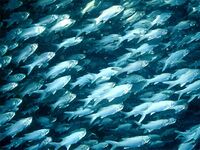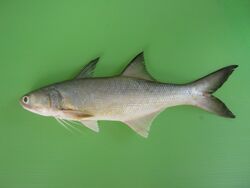Biology:Threadfin
| Threadfin | |
|---|---|

| |
| Atlantic threadfin, Polydactylus octonemus | |
| Scientific classification | |
| Script error: No such module "Taxobox ranks".: | Animalia |
| Script error: No such module "Taxobox ranks".: | Chordata |
| Script error: No such module "Taxobox ranks".: | Actinopterygii |
| Script error: No such module "Taxobox ranks".: | Perciformes |
| Script error: No such module "Taxobox ranks".: | Polynemidae Rafinesque, 1815[1] |
| Genera | |
|
See text | |
Threadfins are silvery grey perciform fish of the family Polynemidae. Found in tropical to subtropical waters throughout the world, the threadfin family contains eight genera and about 40 species.[2] An unrelated species sometimes known by the name threadfin, Alectis indicus, is properly the Indian threadfish (family Carangidae).
Ranging in length from 11 cm (4.5 in) in the dwarf threadfin (Parapolynemus verekeri) to 2 m (6.6 ft) in fourfinger threadfin (Eleutheronema tetradactylum) and giant African threadfin (Polydactylus quadrifilis), threadfins are both important to commercial fisheries as a food fish, and popular among anglers. Their habit of forming large schools makes the threadfins a reliable and economic catch.
Description
Their bodies are elongated and fusiform, with spinous and soft dorsal fins widely separated. Their tail fins are large and deeply forked, indicating speed and agility. The mouth is large and inferior; a blunt snout projects far ahead. The jaws and palate possess bands of villiform (fibrous) teeth. Their most distinguishing feature is their pectoral fins: they are composed of two distinct sections, the lower of which consists of three to seven long, thread-like independent rays. Polynemus species may have up to 15 of these modified rays.

In some species, such as the royal threadfin (Pentanemus quinquarius), the thread-like rays may extend well past the tail fin. This feature explains both the common name threadfin and the family name Polynemidae, from the Greek poly meaning "many" and nema meaning "filament." Similar species, such as the mullets (family Mugilidae) and milkfish (family Chanidae), can be easily distinguished from threadfins by their lack of filamentous pectoral rays.
Distribution and habitat
Threadfins frequent open, shallow water in areas with muddy, sandy, or silty bottoms; they are rarely seen at reefs. Their pectoral rays are thought to serve as tactile structures, helping to find prey within the sediments. Noted for being euryhaline, threadfins can tolerate a wide range of salinity levels. This attribute allows threadfins to enter estuaries and even rivers. They feed primarily on crustaceans and smaller fish.
Reproduction
Presumed to be pelagic spawners, threadfins probably release many tiny, buoyant eggs into the water column, which then become part of the plankton. The eggs float freely with the currents until hatching.
Cuisine
Threadfin has been used to create crab stick.
Mariculture
In Hawaii, sixfinger threadfins are the subject of commercial open-ocean cage mariculture.[5][6]
Genera and species



The species in eight genera are:
- Genus Eleutheronema
- Eleutheronema rhadinum (Jordan & Evermann, 1902) (East Asian fourfinger threadfin)
- Eleutheronema tetradactylum (Shaw, 1804) (Fourfinger threadfin)
- Eleutheronema tridactylum (Bleeker, 1849) (Threefinger threadfin)
- Genus Filimanus
- Filimanus heptadactyla (Cuvier, 1829) (Sevenfinger threadfin)
- Filimanus hexanema (Cuvier 1829) (Javanese threadfin)
- Filimanus perplexa Feltes 1991 (Splendid threadfin)
- Filimanus sealei (Jordan & Richardson, 1910) (Eightfinger threadfin)
- Filimanus similis Feltes 1991 (Indian sevenfinger threadfin)
- Filimanus xanthonema (Valenciennes, 1831) (Yellowthread threadfin)
- Genus Galeoides
- Galeoides decadactylus (Bloch, 1795) (Lesser African threadfin)
- Genus Leptomelanosoma
- Leptomelanosoma indicum (Shaw, 1804) (Indian threadfin)
- Genus Parapolynemus
- Genus Pentanemus
- Genus Polydactylus (likely not monophyletic[7])
- Polydactylus approximans (Lay & Bennett, 1839) (Blue bobo)
- Polydactylus bifurcus Motomura, Kimura & Iwatsuki, 2001 (Slender fivefinger threadfin)
- Polydactylus longipes Motomura, Okamoto & Iwatsuki, 2001 (Long-limb threadfin)
- Polydactylus luparensis Lim, Motomura & Gambang, 2010 (Sarawak giant threadfin)
- Polydactylus macrochir (Günther, 1867) (King threadfin)
- Polydactylus macrophthalmus (Bleeker, 1858) (River threadfin)
- Polydactylus malagasyensis Motomura & Iwatsuki, 2001 (African blackspot threadfin)
- Polydactylus microstomus (Bleeker, 1851) (Smallmouth threadfin)
- Polydactylus mullani (Hora, 1926) (Arabian blackspot threadfin)
- Polydactylus multiradiatus (Günther, 1860) (Australian threadfin)
- Polydactylus nigripinnis Munro, 1964 (Blackfin threadfin)
- Polydactylus octonemus (Girard, 1858) (Atlantic threadfin)
- Polydactylus oligodon (Günther, 1860) (Littlescale threadfin)
- Polydactylus opercularis Seale & Bean, 1907 (Yellow bobo)
- Polydactylus persicus Motomura & Iwatsuki, 2001 (Persian blackspot threadfin)
- Polydactylus plebeius (Broussonet, 1782) (Striped threadfin)
- Polydactylus quadrifilis (Cuvier, 1829) (Giant African threadfin)
- Polydactylus sexfilis (Valenciennes, 1831) (Sixfinger threadfin)
- Polydactylus sextarius (Bloch & Schneider, 1801) (Blackspot threadfin)
- Polydactylus siamensis Motomura, Iwatsuki & Yoshino, 2001 (Largemouth striped threadfin)
- Polydactylus virginicus (Linnaeus, 1758) (Barbu)
- Genus Polynemus
- Polynemus aquilonaris Motomura, 2003 (Northern paradise fish)
- Polynemus bidentatus Motomura & Tsukawaki, 2006
- Polynemus dubius Bleeker, 1854 (Eastern paradise fish)
- Polynemus hornadayi Myers, 1936 (Hornaday's paradise fish)
- Polynemus kapuasensis Motomura & van Oijen, 2003 (Kapuas elegant paradise fish)
- Polynemus melanochir Valenciennes, 1831 (Blackhand paradise fish)
- Polynemus multifilis Temminck & Schlegel, 1843 (Elegant paradise fish)
- Polynemus paradiseus Linnaeus, 1758 (Paradise threadfin)
Timeline of genera
<timeline> ImageSize = width:1000px height:auto barincrement:15px PlotArea = left:10px bottom:50px top:10px right:10px
Period = from:-65.5 till:10 TimeAxis = orientation:horizontal ScaleMajor = unit:year increment:5 start:-65.5 ScaleMinor = unit:year increment:1 start:-65.5 TimeAxis = orientation:hor AlignBars = justify
Colors =
#legends id:CAR value:claret id:ANK value:rgb(0.4,0.3,0.196) id:HER value:teal id:HAD value:green id:OMN value:blue id:black value:black id:white value:white id:cenozoic value:rgb(0.54,0.54,0.258) id:paleogene value:rgb(0.99,0.6,0.32) id:paleocene value:rgb(0.99,0.65,0.37) id:eocene value:rgb(0.99,0.71,0.42) id:oligocene value:rgb(0.99,0.75,0.48) id:neogene value:rgb(0.999999,0.9,0.1) id:miocene value:rgb(0.999999,0.999999,0) id:pliocene value:rgb(0.97,0.98,0.68) id:quaternary value:rgb(0.98,0.98,0.5) id:pleistocene value:rgb(0.999999,0.95,0.68) id:holocene value:rgb(0.999,0.95,0.88)
BarData=
bar:eratop bar:space bar:periodtop bar:space bar:NAM1 bar:NAM2
bar:space bar:period bar:space bar:era
PlotData=
align:center textcolor:black fontsize:M mark:(line,black) width:25 shift:(7,-4) bar:periodtop from: -65.5 till: -55.8 color:paleocene text:Paleocene from: -55.8 till: -33.9 color:eocene text:Eocene from: -33.9 till: -23.03 color:oligocene text:Oligocene from: -23.03 till: -5.332 color:miocene text:Miocene from: -5.332 till: -2.588 color:pliocene text:Plio. from: -2.588 till: -0.0117 color:pleistocene text:Pleist. from: -0.0117 till: 0 color:holocene text:H.
bar:eratop from: -65.5 till: -23.03 color:paleogene text:Paleogene from: -23.03 till: -2.588 color:neogene text:Neogene from: -2.588 till: 0 color:quaternary text:Q.
PlotData=
align:left fontsize:M mark:(line,white) width:5 anchor:till align:left
color:miocene bar:NAM1 from: -23.03 till: 0 text: Pentanemus color:miocene bar:NAM2 from: -11.608 till: 0 text: Polydactylus
PlotData=
align:center textcolor:black fontsize:M mark:(line,black) width:25
bar:period from: -65.5 till: -55.8 color:paleocene text:Paleocene from: -55.8 till: -33.9 color:eocene text:Eocene from: -33.9 till: -23.03 color:oligocene text:Oligocene from: -23.03 till: -5.332 color:miocene text:Miocene from: -5.332 till: -2.588 color:pliocene text:Plio. from: -2.588 till: -0.0117 color:pleistocene text:Pleist. from: -0.0117 till: 0 color:holocene text:H.
bar:era from: -65.5 till: -23.03 color:paleogene text:Paleogene from: -23.03 till: -2.588 color:neogene text:Neogene from: -2.588 till: 0 color:quaternary text:Q.
</timeline>
References
- ↑ Richard van der Laan; William N. Eschmeyer; Ronald Fricke (2014). "Family-group names of Recent fishes". Zootaxa 3882 (2): 001–230. doi:10.11646/zootaxa.3882.1.1. PMID 25543675. https://biotaxa.org/Zootaxa/article/view/zootaxa.3882.1.1/10480.
- ↑ "Inserts for pages 437-441". John Wiley & Sons Limited. https://81a86d48-a-62cb3a1a-s-sites.googlegroups.com/site/fotw5th/Inserts%20for%20pp.%20437-441%20in%20FotW5.pdf?attachauth=ANoY7cru1eiQxyWX8FftCgaTlRq9uD0uYDI1EC32O0iAg-exxLlJoV0tig3JxqIskoE9lDff-FZQgh-HnL2SjOMJcBU3obkvnrkdEJJK-81gj_tCcLedWnb6FgxKVLIY_TGKddKHUVwBuXDEv_JTYPh-mLSQcdVoFfVTHyK-UfvJzknKcwPrwv1Emc1ecKU8OkALrUr6PX_CEHQIjheLBwZ3EwOb7kqz8iSpmirHBGnnbtpJx1aiszU%3D&attredirects=0.
- ↑ Froese, Rainer and Pauly, Daniel, eds. (2019). "Polydactylus sexfilis" in FishBase. August 2019 version.
- ↑ Suryanata, Krisnawati; Umemoto, Karen N. (2005). "Tension at the nexus of the global and local: culture, property, and marine aquaculture in Hawai'i". Environment and Planning A 35 (2): 199, 206. doi:10.1068/a35116.
- ↑ Lin, DT; Bailey-Brock, JH (2008). "Partial recovery of infaunal communities during a fallow period at an open-ocean aquaculture". Marine Ecology Progress Series 371: 65–72. doi:10.3354/meps07675. Bibcode: 2008MEPS..371...65L. https://www.int-res.com/abstracts/meps/v371/p65-72/.
- ↑ Lee, HW; Bailey-Brock, JH; McGurr, MM (2006). "Temporal changes in the polychaete infaunal community surrounding a Hawaiian mariculture operation". Marine Ecology Progress Series 307: 175–185. doi:10.3354/meps307175. Bibcode: 2006MEPS..307..175L. https://www.int-res.com/abstracts/meps/v307/p175-185/.
- ↑ Girard, Matthew G.; Davis, Matthew P.; Baldwin, Carole C.; Dettaï, Agnès; Martin, Rene P.; Smith, W. Leo (2022). "Molecular phylogeny of the threadfin fishes (Polynemidae) using ultraconserved elements" (in en). Journal of Fish Biology 100 (3): 793–810. doi:10.1111/jfb.14997. ISSN 1095-8649. PMID 35137410. https://onlinelibrary.wiley.com/doi/abs/10.1111/jfb.14997.
- Sepkoski, Jack (2002). "A compendium of fossil marine animal genera". Bulletins of American Paleontology 364: 560. http://strata.ummp.lsa.umich.edu/jack/showgenera.php?taxon=611&rank=class. Retrieved 2011-05-19.
External links
- Fisheries Western Australia - Threadfins Fact Sheet
- The Paradise threadfin, Polynemus paradiseus
- Offshore aquaculture project yields a traditional Hawaiian delicacy
Wikidata ☰ Q924957 entry
id:Senangin
 |
